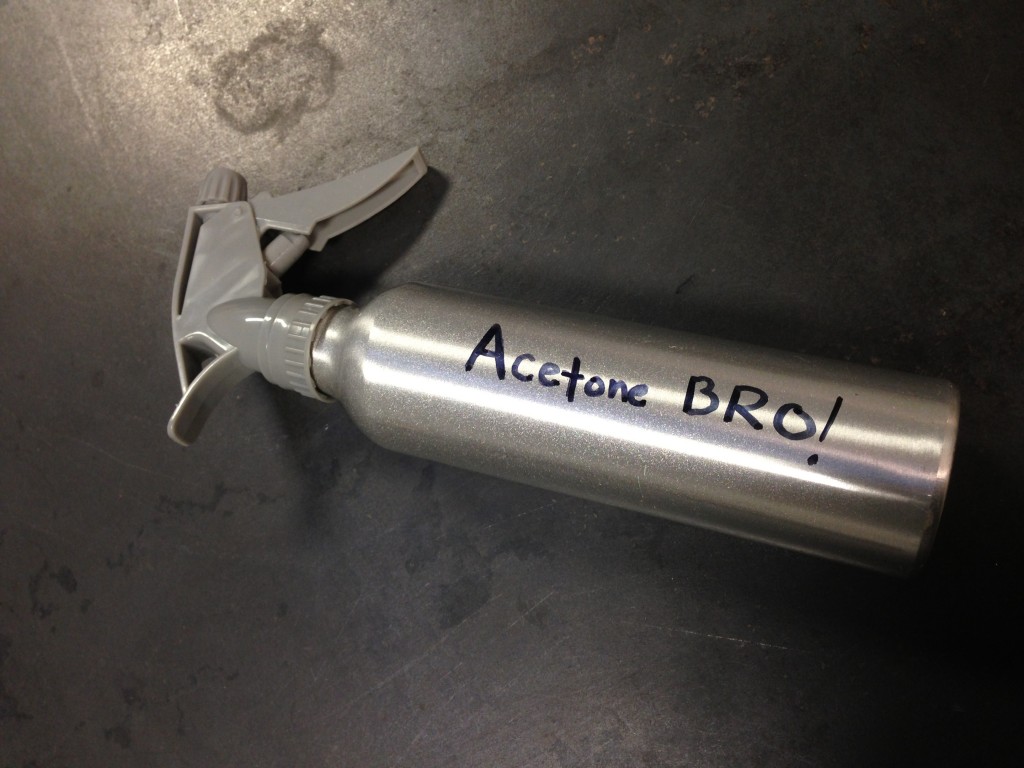Recent conversation has prompted the topic of “Prep is everything” around here at Fabrication Life. This is a rule, a token of wisdom that should help anyone produce higher quality welds and finished products. Seriously, why should the end product of fabrication get all of the attention in the process? We hope this will open our readers minds to the importance of quality prep-work in the grand scheme of fabrication. It is one of the most important moments in the process and one that it often times overlooked – leaving the work much to be desired.
A novice welder will not have as much frustration trying to figure out why his weld is “bad” or will have a better first experience if they are practicing the good prep and cleaning techniques. In some cases you will spend more time on prep than the actual weld.
Never fear, we’ve compiled a small simple list of tips to help you sharpen your prep skills to the finest and sharpest blade in your arsenal.
Chemical Cleanse
Chemical prep when welding can be a touchy topic, which is why this topic is brought up 1st. Safety when welding is the single most important task of anyone with the arc ready and in position.
Chemicals Commonly used:
-
Acetone
-
Denatured Alcohol
-
Dehumidified Water
-
Mineral Spirits
Caution:
Do not use brake cleaner for cleaning cast materials, or at all. The film left behind is very toxic and will suffocate you especially with the combination of cast aluminum.
Grinding
If you do not prep the metal properly, you risk the joints not joining properly, the values may differ from the metals used in the project. and you risk failing to meet the requirements of the job at hand entirely.
This all can relate to one item of the prep, The Wire Brush. While the styles and sizes vary on what you can use, the choice to wire is not really a choice- it is a must! You will benefit in the long run. You should have a dedicated tungsten grinding wheel versus metal wheel. This same practice can be applied for the wire brushes too- stainless steel brush vs a dedicated aluminum brush. These are all tips to help your process.
Also try not to cross contaminate. For example, many guys will clean their pipe before cutting it. But yet they are cutting the pipe with a chop saw. Chop saw debris can embed itself in the pipe causing black spots in their welds. Best method is to use a band saw of sorts, metal against metal cutting. If you are using a band saw make sure you use clean blades constantly to battle against cross contamination.
Deburring
Don’t compromise a fabricated item due to improper material prep, and by that we mean, get rid of those shards and burrs. Why on earth would you weld jagged items and expect the most secure and aesthetically pleasing welds? Not to mention compromise strength of the part due to faulty joins. Once you are finished with your cutting, welding, deburr the item. There are many tools to assist you in this task. Wire Wheels, a simple pick, abrasive belts, rotary brushes, and blades to ensure your project stays Burr Free.
Safety Items for Prep
You need eyes and limbs, don’t risk injury from something as simple as using the proper safety equipment. This is not rocket science, but will keep you working another day. Keep yourself away from burns, cuts, and heat if at all possible. Your eyes can especially be protected here with a simple pair of safety glasses, which can be sourced from any local store these days for around $1-2 dollars.
Remember for safety:
-
Gloves
-
Glasses/Goggles
-
Well lit work area
Mock
Mocking parts up is to see what you are doing as a whole. This process can be applied from manifolds to structural bars. Angles are always different in your creation can always become better. Your mock may show you something you did not account for in the initial planning. It will provide grounds for your finished product.
Fit
Fitting your edges, piping, braces, tubes, joints, etc. is another key process when you are prepping a job. This may not fall into normal means of prep, but if you do not fit materials meticulously, the outcome often may not be to the desired specifications. Know the process and job you are going into. Have a grasp on what you are planning to accomplish, and complete the job at hand.
Measure
We understand when you purchase products from a company you expect them to be the proper sizes ordered. I mean, you ordered a 14” section of piping for your turbo kit or a 20” flat of galvanized steel. If you want to ensure saving yourself time in the future, be the fabricator. ALWAYS measure and check your clearances and length. That ¼ inch, those millimeters missing- otherwise known as out of spec, will have you off when in the middle of the job.
Work smarter, not harder.
Soon we will give more information on other parts of prep including Grinding and Marking. Keep reading FabricationLife.com
Thank you to Dezod Development, SpeedFactory, Toxicfab, Vibrant Performance, and Bergenholtz











